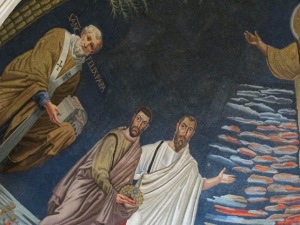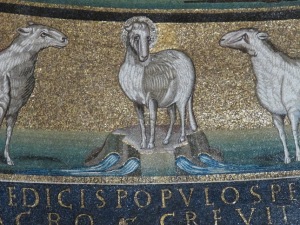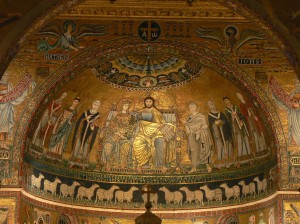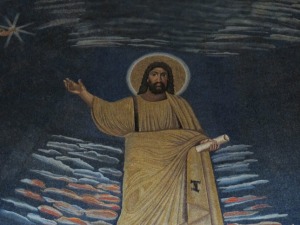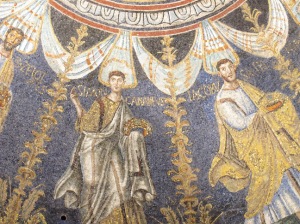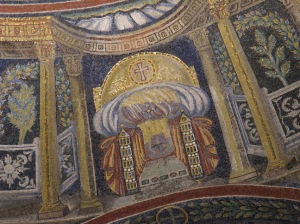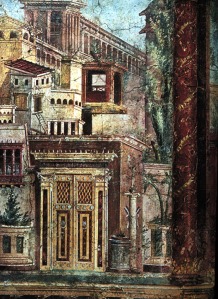The Birth of Christian Art: The Basilica of Saints Cosmas & Damian
The verdigris door in the photo above belongs to a temple in the Roman Forum, traditionally said to have been dedicated to Romulus, the infant son of the Emperor Maxentius. About a century after the mosaics at Santa Pudenziana (about which I spoke in my last post), and half a century after the last emperor in Rome had been deposed, the temple was incorporated into the church of Saints Cosmas and Damian by Pope Felix IV (526-30).
Over a millennium after the church was built, major modifications were undertaken. These saw the narrowing of the apse to make way for new side chapels which rather brutally cut into the mosaics, but the central part of the original apse mosaic survives largely intact.
The inscription at the base of the mosaic tells us that, “Felix has offered this gift worthy of the lord bishop so that he may live in the highest vault of the airy heavens.” I rather like the gumption with which he makes this deal with the Almighty.
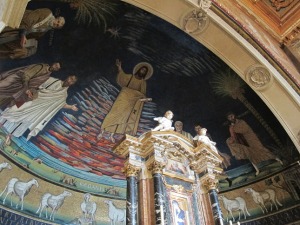
Apse, Basilica of Saints Cosmas and Damian
Dominating the apse is the bearded figure of Christ. A forbidding figure, his right hand, replete with stigmata, is raised to indicate the phoenix in a palm tree. The bird which rose from the ashes becomes in Christian art a symbol of the resurrection.
On either side, and more solidly rooted on earth, are Saints Peter (always shown with white hair) on the left and Paul on the right (always shown with a domed head and a brown beard). Peter presents Cosmas, while Paul presents Damian. On the far right St Theodore lurks nervously, while on the left Pope Felix IV, his face heavily restored, holds a model of the church he dedicated.
Below twelve sheep represent the apostles. They form a procession leading towards the agnus dei, the lamb of God, which stands on a rock from which flow the four rivers of paradise.
This programme – Christ, saints on either side, the donor, and the sheep below – would become the standard for apse mosaics for the next eight hundred years. For example Santa Maria in Trastevere, mid twelfth century.
We can compare with the mosaics at Santa Pudenziana (images can be found in my previous post here). There Christ is involved in discussion, here he is completely removed from the scene. Far larger than the other figures, and neither old nor young, he floats on the fiery flame-coloured clouds in an entirely different realm from the other figures. Indeed they are not looking towards him but out at us; it is as if the Christ figure appears both to them and to us as a communal vision.
While the image of Christ at Santa Pudenziana was distilled from the Roman model of the orator, here we see a figure which has entirely broken the pragmatic shackles of Roman realism. This Christ fully embraces the transcendental nature of Christianity, so different from the Roman religion. I spoke of “Roman Christian-ness” at Santa Pudenziana, this, perhaps for the first time, is a fully Christian art.
If the spirit of naturalism of Roman Imperial art has been transformed into something else, the hierarchy of the Roman world is still very much present. Christ is robed in a gold toga edged with purple, the inverse of the toga picta (purple embroidered with gold) reserved for victorious generals, consuls, and emperors. The analogy of Imperial power is used to indicate rule over the realm of heaven, of triumph over death. The togas of Peter and Paul mark them out as Romans of substance, but unlike the dynamic realism of the gestures of the apostles at Santa Pudenziana, their poses are identical in their indication of the figure (vision) of Christ. Similarly Cosmas and Damian, dressed as Byzantine princes and bearing the crowns of their martyrdoms, exactly mirror one another. A residual naturalism can be seen in the positions of their feet and the shadows they cast, especially Damian on the left.
The abstract and formal nature of the mosaic marks the first flowering of a truly Byzantine art in Rome. Too often we are tempted to think of the loss of perspective after the fall of the Roman Empire as just that, a “loss”. For so long the plodding banality of much art history wanted us to place value judgements on Late Imperial and Medieval art based on realism, an entirely subjective and arbitrary parameter. Are Michelangelo’s figures on the ceiling of the Sistine Chapel realistic, is Picasso’s Guernica realistic? The question of success in art is more complicated, the achievement of representation depends on what is to be represented. The art of Byzantium, driven by the focus on the divine, the intangible, the future heavenly world, retreated from the classical search for realism (how do you represent heaven?) into a symbolism which could be meditated on by the faithful. The very nature of Christianity meant that art did not need to do all the work, but became a tool through which internal visions could be achieved.
The wildly eminent Byzantine art historian (and sometime Professor at my alma mater) David Talbot-Rice uses a wonderful analogy. He speaks of a quotation from the Indian Nobel Laureate Rabindranath Thakur who said of Indian music:
“Our master singers never take the least trouble to make their voices attractive. Those of the audience whose senses have to be satisfied are held to be beneath any self-respecting artist. Those of the audience who are appreciative are content to perfect the song in their own mind by the force of their own feeling.”
Just as the music he speaks of as the symbol which sparks another concert within the soul, so the art of Byzantium offers the same formal symbolism, a mantra to provoke meditation on the divine. It’s neither better nor worse, just different.
This would make a super part of a tour of Early Christian art, or perhaps a 4 hour extended version of my “Heart of Ancient Rome” itinerary
Basilica of Saints Cosmas and Damian,
via dei Fori Imperiali, 1
Open every day 9am-1pm, 3pm-7pm

